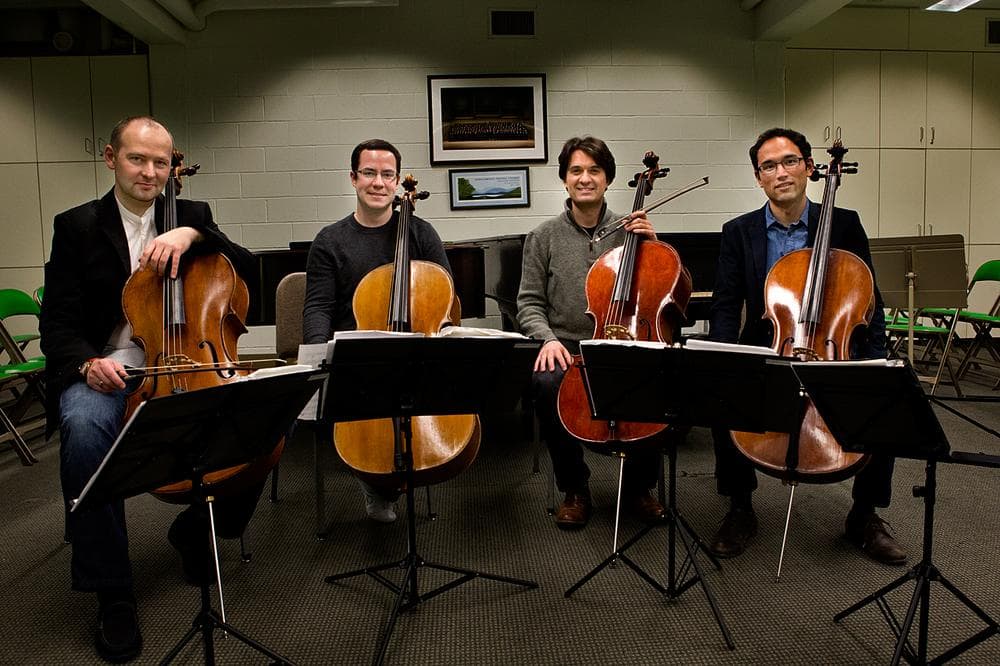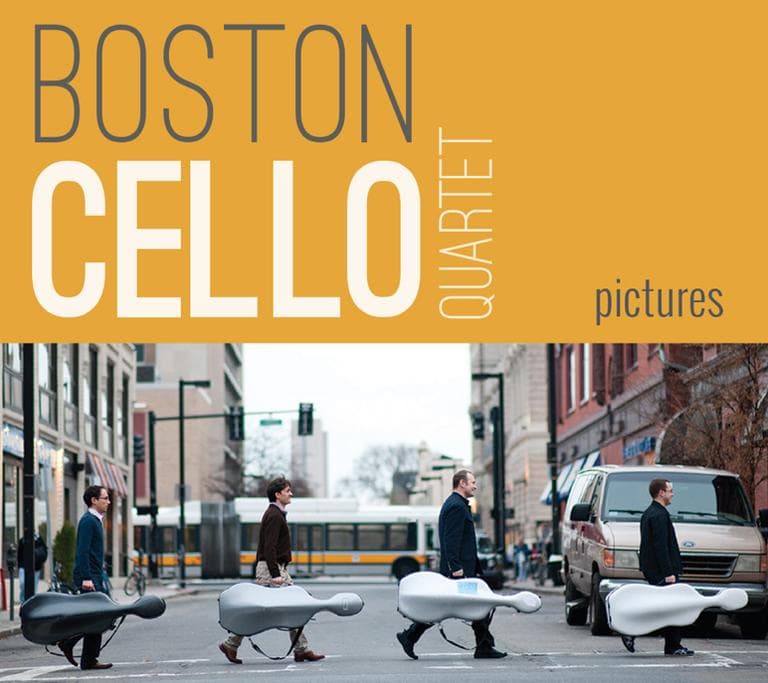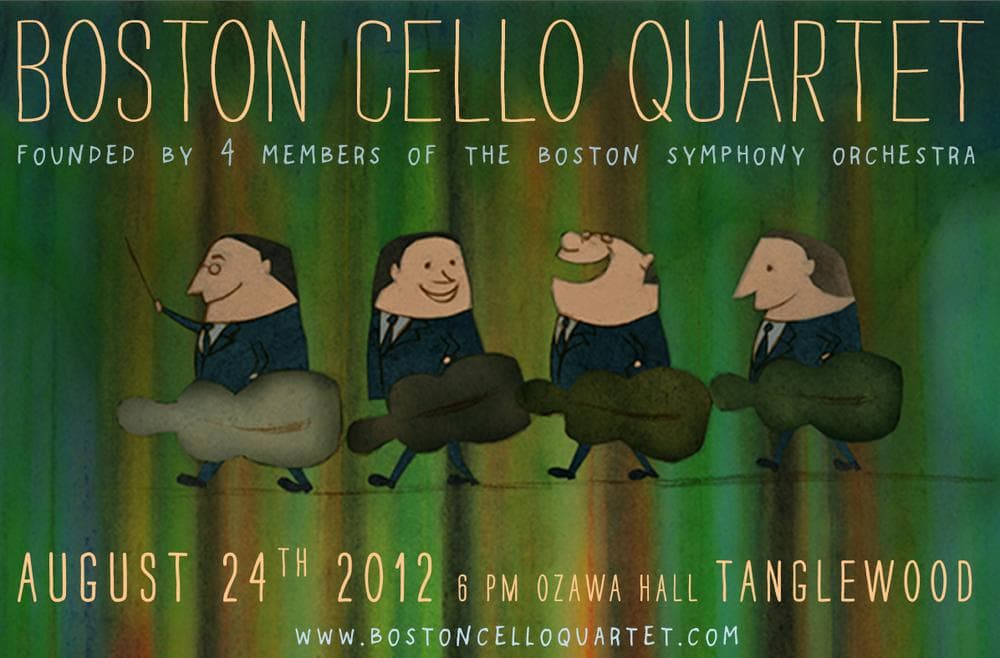Advertisement
The Boston Symphony Orchestra's Cello 'Boy Band'

In traditional orchestras, the cellos usually operate in the background, creating bass lines and harmonies to support melodies led by the violins or wind section. But four members of the Boston Symphony Orchestra’s cello section are taking their beloved instruments into the spotlight with a group they're calling the Boston Cello Quartet.
The young musicians hail from France, Romania and the United States and are celebrating the release of their debut album, “Pictures,” Friday night.

The album's cover photo is an obvious play on the iconic Beatles album, "Abbey Road." In it, four men cross a city street single file — except here they’re carrying cello cases and crossing St. Stephen Street near Symphony Hall. It's hard to resist calling the quartet a cello boy band.
"You mean we all look good, right, that’s what you’re saying?" Blaise Dejardin, 28, asked with a laugh. "Yeah, why not?"
He took the image further saying the quartet even opened for the rock band Train at Tanglewood two summers ago.
"So I guess we were a bit of a boy band there, but we kept our shirts on!" Dejardin joked.
More seriously, though, the professional classical musician says performing on the same bill with a pop group, and finally releasing their first album, plays into the quartet's mission.
"We are crazy about the cello, we think it’s a great instrument so we want to showcase it," Dejardin explained. "And also to show that classical music is not just for old people or just for serious people. It’s just really fun and it conveys lots of emotions."
The four musicians have been playing their cellos since they were little kids. At a recent rehearsal in the basement of Symphony Hall, 37-year-old Mihail Jojatu remembered when his mom took him to a cello concerto in Romania.
"I whispered to her and I said, 'I want to play that!' "
Jojatu’s fascination endured. He still marvels at his instrument’s versatility.
"I love the differences in colors. You can sound like a violin and you can sound like a double bass and you can sound like a viola and you can sound like a cello," he said. "I think none of those instruments have this range."
That range makes the cello quartet work, Jojatu says, because the musicians can actually play all of the parts composed for traditional string quartets.
"[We want to] show that classical music is not just for old people or just for serious people. It’s just really fun and it conveys lots of emotions.”
Blaise Dejardin
"This is the difference between a string quartet and what we’re doing," Jojatu said. "Usually the cello plays the bass in a string quartet, but here somebody is playing the theme."
Musical Chairs
Something else that makes this cello group different from other string quartets is the fact that they rotate leaders for each song. It's a democratic move because usually one of the two violins would take charge of an ensemble.
The group's album release concert will be like a game of musical chairs, according to Graham Wright. He’s hosting the gig as part of his fledgling salon series, Opus Affair, but grapples a bit with calling this quartet a cello boy band.
"In the sense that these boy bands tend to appeal to diverse crowds? Maybe," he said with a laugh. "But not in the sense that they’re manufactured to sell albums."
The cello quartet’s new album is designed to show off their instrument’s potential. It features a mix of classics and original compositions. They do a version of Modest Mussorgsky's “Pictures at an Exhibition,” a suite originally composed for piano and often played on the trumpet. But they also play the James Bond theme as part of a medley arranged by Dejardin.
Advertisement
Cellists Are People, Too
Thirty-six-year-old Adam Esbensen thinks the cello shines the brightest when it's doing slow, lyrical pieces. "When it sounds like a singer," he explained.
Esbensen sees the cello quartet as a chance to connect more intimately with audiences, which can be tough, he says, as a musician sitting on the stage with the 100-person Boston Symphony Orchestra.
"It’s important for them to see us as actual human beings who have fun and laugh," he said, "and aren’t just up there in our tails staring at our music."

BSO Assistant Artistic Director Ben Schwartz said it's important to see the other sides of these musicians. "They're totally informal, they're cool, they understand pop references and aren't uniform in their musical taste," he said. "They like all kinds of stuff, from blues to jazz to rock and video games."
Schwartz is a cellist himself and said while there are a lot of string quartets in the world, "There just aren’t that many cello quartets out there."
Or cello boy bands.
"I may have teased them about the boy band aspect," Schwartz joked. "They each had to find their identity: Which one is going to be the bad boy? Which one is going to be the one that every girl wants to take home to her mother? Which one is going to get in trouble with the law?"
But Schwartz hopes no one has any run-ins with the police because he and the rest of the BSO need the cellists for their "day jobs" at Symphony Hall.
The Boston Cello Quartet celebrates the release of their debut album, “Pictures,” Friday, Feb. 1, as part of Opus Affair's salon program at the Hotel Revere in Boston.
This segment aired on February 1, 2013.

